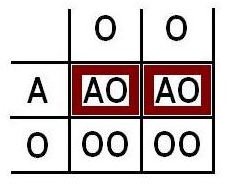What determines blood types? It's all genetics: the ABO blood types and genetics
ABO Blood Types
Red blood cells are responsible not only for the blood color but for carrying vital oxygen molecules to our body’s tissues and cells. Blood types are classified according to the absence or presence of substances on the surface of blood cells.
The surface of blood cells are covered with glycoproteins which project out into the blood stream. These glycoprotein chains (called agglutinogens) can be detected by antibodies. There are two different types of agglutinogens, type “A” and type “B”. The ABO blood type classification system uses the presence or absence of these molecules to categorize blood into four types: blood type A (antigen-A present), blood type B (antigen B present), blood type AB (both antigen A and B present), and blood type O (antigen A and B absent). The presence or absence of antigens A or B has a genetic basis
The Genetics of Blood Types
Having examined the biochemistry behind the ABO blood types let’s look at the genetics of the blood types. The human <em>ABO</em> gene is located on chromosome 9. This gene has 3 variants (alleles).
The A allele encodes for an enzyme called N-acetylaminogalactosyltransferase which makes the A antigen that confers blood type A. A mutation on this gene conforms the B allele. This encodes for another enzyme that makes the B antigen and confers the blood type B to the carrier of this allele.
Everyone has two copies of the ABO human gene (chromosome 9). If both of them are the A allele then your genotype (genetic makeup) will be AA. If both of them are the B alleles then your genotype will be BB. A person could have one A and one B in which case his (or her) blood genotype will be AB and if an individual has neither A nor B, their genotype will be OO. Each of the alleles A or B are dominant with respect to the allele O (which is recessive). A and B are co-dominant, which means that if both are present neither of them dominate over the other (both show up in the phenotype).
Blood Type Inheritance
A child’s blood type can be predicted with a high degree of certainty from the parent’s blood types. To do that a “Punnet Square” is constructed. In a Punnett Square the alleles from one parent are listed on one side and the alleles from the other parent are listed on the top. Let’s suppose the we have a parent with A type blood (and genotype AO) and the other parent with O type (OO genotype). Then the Punnet square will look something like this:
You can see that there is a 50% chance of a child born to these parents having an AO blood genotype (type A) and a 50% chance of type O (OO genotype).
Sources:
